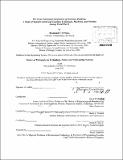| dc.contributor.advisor | David A. Mindell. | en_US |
| dc.contributor.author | O'Mara, Raymond P. (Raymond Patrick) | en_US |
| dc.contributor.other | Massachusetts Institute of Technology. Engineering Systems Division. | en_US |
| dc.date.accessioned | 2011-12-19T18:47:01Z | |
| dc.date.available | 2011-12-19T18:47:01Z | |
| dc.date.copyright | 2011 | en_US |
| dc.date.issued | 2011 | en_US |
| dc.identifier.uri | http://hdl.handle.net/1721.1/67754 | |
| dc.description | Thesis (Ph. D.)--Massachusetts Institute of Technology, Engineering Systems Division, 2011. | en_US |
| dc.description | Cataloged from PDF version of thesis. | en_US |
| dc.description | Includes bibliographical references (p. 353-368). | en_US |
| dc.description.abstract | This dissertation examines the creation and initial use of the precision bombing system employed by the United States Army Air Forces during World War II in the opening phase of the Combined Bomber Offensive against Germany. It presents the system as distinctly sociotechnical, constructed of interdependent specially trained humans-the pilot, navigator, and bombardier-purpose-built automated machines-the Norden bombsight and the Minneapolis- Honeywell C-1 Autopilot-and the high-altitude, daylight bombing (HADPB) doctrine, all of which mutually shaped each other's creation and use. The first part of the study establishes the relationship between the HADPB doctrine, the humans, and the machines, presenting the bombardment system as a three-level socio-technical system designed for optimum control at all levels. It describes the elements at each level, their design for use as a system, how they initially employed the system, and how their actions caused a revision of the HADPB doctrine, in the process redefining precision from a system perspective and significantly changing the system's social structure. The second part of the study examines the actions performed by the three principal sociotechnical members the bomber crew, and determines the specific tasks and roles accomplished both the humans and machines within the system. It establishes what the crewmembers did, analyzing their professional construct, the machines that shaped their professional identities, how the humans and machines, through distinct processes of shared control and cognition, accomplished the tasks associated with precision bombing-flying, navigating, and bombingand how the HADPB doctrine affected their actions. It focuses on how technology, by granting varying levels of control over the task of flying the aircraft, created conflict over control of the system itself, and how command, a uniquely military function granted organizationally and doctrinally to the pilot, served as arbiter of that conflict. This study establishes a perspective for the future study aerial combat systems, and a better understanding of the organizational and social impact of the increased use of automation in those systems, particularly relevant to the discussion surrounding the expanded use of remotely piloted aircraft by the United States Air Force in the conflicts in Iraq and Afghanistan. | en_US |
| dc.description.statementofresponsibility | by Raymond P. O'Mara. | en_US |
| dc.format.extent | 368 p. | en_US |
| dc.language.iso | eng | en_US |
| dc.publisher | Massachusetts Institute of Technology | en_US |
| dc.rights | M.I.T. theses are protected by
copyright. They may be viewed from this source for any purpose, but
reproduction or distribution in any format is prohibited without written
permission. See provided URL for inquiries about permission. | en_US |
| dc.rights.uri | http://dspace.mit.edu/handle/1721.1/7582 | en_US |
| dc.subject | Engineering Systems Division. | en_US |
| dc.title | The socio-technical construction of precision bombing : a study of shared control and cognition by humans, machines, and doctrine during World War II | en_US |
| dc.type | Thesis | en_US |
| dc.description.degree | Ph.D. | en_US |
| dc.contributor.department | Massachusetts Institute of Technology. Engineering Systems Division | |
| dc.identifier.oclc | 766546254 | en_US |
